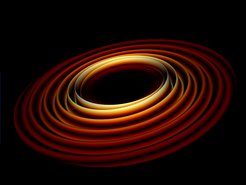Exploring colliding black holes and neutron stars
Newly established Max Planck Independent Research Group in Hannover
In January 2017 – just one year after the dawn of gravitational-wave astronomy – the Max Planck Institute for Gravitational Physics (Albert Einstein Institute; AEI) has expanded through the addition of a young research team. Led by Dr. Frank Ohme, the Max Planck Independent Research Group “Binary Merger Observations and Numerical Relativity” will study collisions of black holes and neutron stars through sophisticated computer simulations, exploring some the fundamental questions in the new field of gravitational-wave astronomy over the next five years.

“When the LIGO instruments detected gravitational waves for the first time on September 14, 2015, we quickly knew that black holes were the source of the signal,” says Dr. Frank Ohme, leader of the Max Planck Independent Research Group. “This was only possible because we knew the shape of such signals from theoretical predictions – solutions of Einstein’s equations.” These equations determine how black holes warp the spacetime around them and thus emit gravitational waves that can be observed with detectors such as LIGO, Virgo, and GEO600.
Simulating gravitational waves in the “Holodeck”
However, the equations are so complicated that the most violent (and most interesting) part of the collision can only be understood by large-scale simulations on supercomputers. To extract every quantum of scientific information from the faint signals, a handful of groups around the world are performing increasingly complex numerical simulations. The newly established Max Planck Independent Research Group at the AEI is one of them. Its researchers operate the computer cluster “Holodeck” for their compute-intensive simulations. “Holodeck” consists of 680 CPU cores connected with a fast InfiniBand network.
“Our goal is to develop models to improve our understanding of black-hole merger dynamics and allow us to observe fascinating phenomena such as precessing binaries or black-hole ‘kicks’.” explains Ohme.
Neutron stars – matter in an exceptional state

In addition to more gravitational waves from colliding black hole binaries, merging double neutron stars are next on the list of most anticipated future detections. Neutron stars are compact remnants from supernova explosion that contain more mass than our Sun in a sphere of only 20 kilometers in diameter. Ohme’s Max Planck Research Group will harness numerical simulations to shed light on the behaviour of extremely dense neutron-star matter. “Nobody knows exactly how matter behaves under the extreme conditions inside neutron stars. By combining our simulations with future observations of gravitational waves from colliding neutron stars we will get entirely new insights into these fascinating objects,” says Ohme.
At the Max Planck Institute for Gravitational Physics in Hannover, Ohme’s group closely collaborates with the division “Observational Relativity and Cosmology” led by Prof. Bruce Allen, the institute’s Managing Director. “I am very happy that Frank Ohme has chosen our institute in Hannover as host institution for his Max Planck Independent Research Group,” says Allen. “This strengthens and broadens our research and positions us even better in the new era of gravitational-wave astronomy.”
Frank Ohme (born 1983) studied physics at the Friedrich-Schiller University in Jena, Germany, and researched for his PhD between 2009 and 2012 at the Max Planck Institute for Gravitational Physics (Albert Einstein Institute; AEI) in Potsdam. His dissertation focused on the interface of numerical-relativity simulations and data analysis in gravitational-wave research. After a short stint as post-doctoral researcher at the AEI in Hannover, he was a researcher at the School of Physics and Astronomy at Cardiff University until the end of 2016. Since the start of 2017 he has been leading the Max Planck Independent Research Group “Binary Merger Observations and Numerical Relativity” at the AEI in Hannover.













